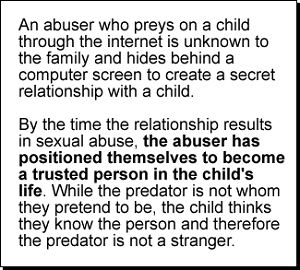Preventing Child Abuse: Understanding Grooming
Posted by PLB · Leave a Comment

 Generally, abusers have a pre-existing relationship with their victims as well as access, authority and trust of both the parent and child. They may involve themselves in a family’s life and often do great things in the community. This is a trick. This is their game. This is their way of being open about being sneaky and of gaining more access to a child. This process is called “grooming.”
Generally, abusers have a pre-existing relationship with their victims as well as access, authority and trust of both the parent and child. They may involve themselves in a family’s life and often do great things in the community. This is a trick. This is their game. This is their way of being open about being sneaky and of gaining more access to a child. This process is called “grooming.”
As part of a grooming process potential abusers might give presents or do favors for children. Grooming, “pay-off” or “guilt gifts” could include unexplained clothes, jewelery, phones, shoes, manicures, etc. Parents should know where all objects come from when a child receives something and children should be told that they need to ask their parents before accepting any gifts. This would help in preventing child abuse.
Grooming can be used on parents and caregivers as well as children. Examples may include: always being there, eagerness to babysit, ability to help with the kids in a pinch, offering (or even creating) concern and willingness to lend support.
Keep in mind that predators need access to children and grooming can become so entrenched into our daily life that we fail to recognize it as grooming. In this way a child’s support network is groomed to believe in the predator and to disbelieve anything that the child may say later about their behavior. If a child says they’ve been abused, always believe them, even if you think it’s impossible.
Preventing child abuse is important and need to be detected early in order to safeguard the child and prevent trauma.
What role can be play in preventing your children from being abused?
From Professional Learning Board’s online continuing education course for teachers: Recognizing & Preventing Child Abuse



